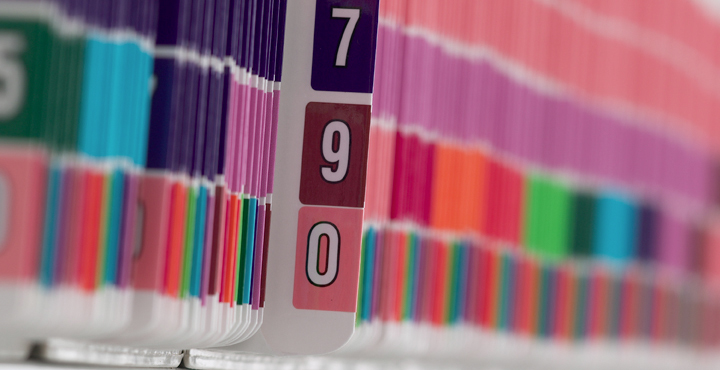
Color-coded filing systems: Reduce downtime and increase ROI – Part 2
Part 1 of this series showed you how color-coding works and who it benefits. We also made the business case for color-coding by demonstrating how it leads to more efficient records retrieval, retention and disposition; improved decision-making; reduced operational down time; fewer lost opportunities; and minimized risk of legal sanctions. In this post, we focus on how color-coding improves your records privacy and information security, as well as your space management.
|
1.0 Privacy and information security
Organizations must safeguard sensitive information against security breaches, and even authorized personnel should only access information as needed to perform legitimate business tasks and transactions. Here’s how color-coding can help:
1.1 Controlled retrieval
Maintaining security means making it difficult for unauthorized parties to find sensitive information. It may not make sense, then, to label and arrange files by the names of the person or company that file relates to. By labeling and arranging files by an internal numbering scheme, an organization limits access to those authorized users who also have access to the indexes necessary to link names with numbers. In most cases, it takes less time to look up a number and then find that number in a color-coded system than it would to leaf through and read many rows or black-and-white text labels.
1.2 Anonymity
The contents of a file can be damaging enough. In some organizations, the mere fact that a file exits for a given subject is itself a piece of highly sensitive information. Consider the example of health care clinics, which commonly use color-coded numeric sequences for patient files. File labels with patient names can provide a virtual list of individuals who have used the clinic’s services. For a clinic that focuses on a particular health complaint or condition, the mere fact that a person is a patient is enough to give clues about diagnosis and treatment details. Along with health care, legal firms, law enforcement authorities and debt collection agencies are just some examples of organizations that could benefit from replacing text-based file labels with a color-coded system.
1.3 Misfile prevention
When an individual’s personal information ends up in someone else’s file, or their file ends up in the wrong location, there is an increased likelihood that staff will access and view that information in error. Similarly, when they cannot find a given file or document, staff may need to skim through any number of files to locate what they need. Accessing information unnecessarily is a compliance risk in its own right, and the more information an employee accesses, the greater the risk that they may use or disclose it illegally. The fast retrieval of a color-coded system mitigates this risk, as employees find exactly what they need—and only what they need—to perform their duties.
2.0 Managing space
With real estate costs rising in pace with business growth, many organizations are forced to house more people, operations and equipment in less space. This problem is especially acute for records management professionals, as growing business means growth in business records. The records management industry has responded to this growing trend with filing equipment and supplies that can store more records using less total floor space. The following filing solutions can help an organization make more efficient use of storage space:
2.1 Lateral filing
More traditional vertical filing arranges files from front to back in a pull-out drawer. A four-foot deep vertical filing cabinet requires an additional four feet of floor space at the front to accommodate the pull out. Lateral filing avoids this problem by arranging the files from left to right, reducing the necessary clearance space to the length of one file folder. When lateral filing is combined with an end-tab folder design, the clearance space drops to zero, as file labels can be read and folders removed without a pull-out drawer or shelf.
2.2 Mobile vs. stationary shelving
Mobile shelving systems are equipped with rollers, which sit on tracks in the floor. Instead of one aisle for every two rows of stationary shelving, a mobile solution can function with as little as one aisle, which users move to access files in a given row. Fewer aisles mean less total floor space needed to store the same volume of files, or more storage potential in the same space.
2.3 End-tab folders
End-tab file folders are designed to hold labels on the side rather than the protruding top tab of more traditional folders. Files can sit upright in open-faced cabinets or shelving, eliminating the need for pull-out drawers and bulky hanging folders. Also, without the protruding top tab, end-tab folders are shorter (in height), allowing the filing system to stack more usable rows of shelving on the same square footage of floor space. Finally, because it is not necessary to have the top of the folder at eye level, end-tab labels allow files to be stored at a higher position while still keeping label information readable.
Pulling it all together
Lateral filing, mobile shelving and end-tab folder solutions can have a dramatic impact on space utilization, but their full potential is realized once they are combined with a color-coding filing solution. While end tabs alone increase the number of filing rows readable from a normal standing position, that visibility range is increased further by color-coding. A color-coded end-tab solution can allow as many as seven easily useable filing rows. As a key component of an integrated storage solution, color-coding can help improve overall space utilization by more than 330%.
Next Steps
- Read part 1 on how color-coding works and who it benefits
- Download our white paper “Optimize Your Records Management Program with Color-Coding”
- Find out how we helped one company save 250k with color-coding
- Talk to a TAB representative about how we can help make your records management more efficient with color-coding
- Purchase your TAB CompuColor highly-customized, factory-printed file labels.





